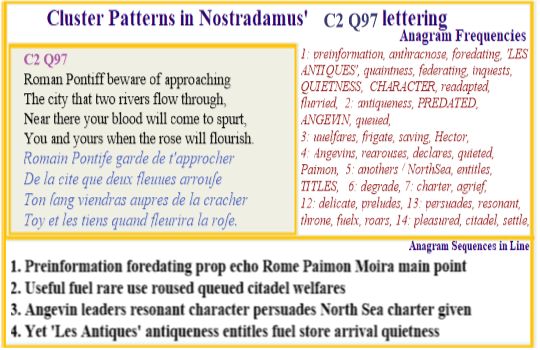 Analyses of all verses
Analyses of all verses
|
 Web Site
Web Site |
 All
Sefirots All
Sefirots |
Nostradamus C2 Q97: Secrets held in St Remy's 'Les Antiques'.
Copyright: Allan Webber, December 2015
 Enigmatic verse is typical of Nostradamus writing but
he claimed every one of the verses was resolvable with an unambiguous
solution. I believe my method of anagram usage is the only method that
could redem his claim.
Enigmatic verse is typical of Nostradamus writing but
he claimed every one of the verses was resolvable with an unambiguous
solution. I believe my method of anagram usage is the only method that
could redem his claim.
For example in the text of this verse it talks of our blood spurting but that is definitely ambiguous for it could be death or a sudden onset of fertility that could fulfill that condition.
And yet the anagrams do allow this verses meaning to be clarified and in a most unusual manner.
Its key lies in the names it contains with 'Les Antiques' ( les tiens qua), Paimon ( main Po), Moira ( Romai) and Angevins ( ſang vien) being amongst the most important. The Angevin and Les Antiques reference identifies the city as that of Glanum whose ruins are slowly being uncovered in a region just outside St Remy in Provence.
The anagrams for Paimon and Moira are two demonic forces with which he buit a resonance with harvests on which his families futures relied.
To this end there are several anagrams related to crops and their diseases aas well as other aspects related to the character of Paimon.
In consequence we can place this verse into a future setting for St Remy and that future is one where the nature of its crops and the reliability of fuel from the North Sea becomes of great concern. These are the events that many verses show approach us as this century ends.
# Paimon: One of the kings of hell with strong allegiance to Lucifer. Paimon teaches all arts, philosophy, science and secret things which includes the secrets of earth, water and that which is held in the mind.
# Moira (Greek mythology): represent one's portion or part in destiny.
# Les Antiques: On the outskirts of St Remy, Provence, (where Nostradamus was born in1503 CE ) are the partially restored ruins of the Roman city of Glanum. In the 16th century the only prominent features of these mostly buried ruins were a triumphal Arch and a Mausoleum called 'Les Antiques'.
# Angevins: a term used for the royal house from the province of Anjou-
# anthracnose (canker): plant diseases in which dead tissue are caused by fungi, bacteria and viruses,